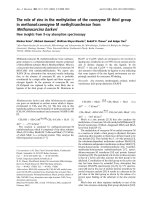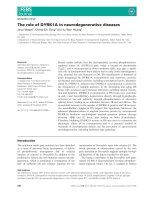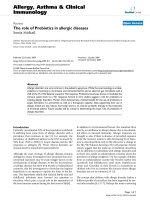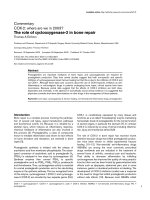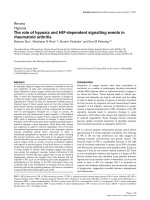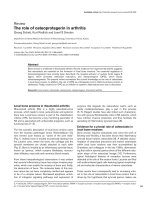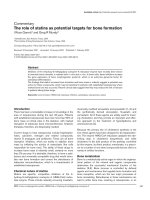Báo cáo y học: "The role of stress in rheumatic diseases" ppsx
Bạn đang xem bản rút gọn của tài liệu. Xem và tải ngay bản đầy đủ của tài liệu tại đây (125.17 KB, 2 trang )
In the present issue of Arthritis Research & erapy, de
Brouwer and colleagues review the literature pertaining
to experimental studies targeting acute-phase reactivity
in the stress-response systems of patients with rheuma-
toid arthritis (RA) and systemic lupus erythematosus
(SLE) [1]. e authors included only studies employing
experimental stressors (psychosocial, cognitive, exercise,
and sensory/pain induction) to evaluate physiological
responses at three levels – the autonomic nervous system
(ANS), the hypothalamic–pituitary–adrenal (HPA) axis,
and the immune system – in patients with RA and SLE.
Sixteen studies were identifi ed [1]. e authors found
inconsistent results regarding experimentally induced
stress and the ANS and HPA axis baseline levels and
reactivity, but found some evidence for alterations in
immune functioning in patients compared with controls.
ey noted that the most consistent fi nding in response
to experimentally induced stress was an increase in the
number of natural killer cells, but this may not be
surprising because natural killer cell traffi cking is very
sensitive to stress hormones such as catecholamines. e
authors note, however, that many of the studies possessed
methodo logical problems of their own. Most studies
were under powered (that is, small sample sizes) and
some failed to control for potential confounders such as
medication use, age, sex, psychiatric comorbidity, stress
coping/appraisal and abuse history. In patients with
rheumatologic illness, the presence of depression and a
history of abuse are relatively common and have been
associated with altera tions in the stress-response and
immune systems [2,3].
e results from the present review of the eff ects of
stress in RA and SLE suggest that the fi ndings in these
disorders are congruent with a broader literature includ ing
both animal models and clinical studies of other rheumatic
disorders. A number of diff erent types of stress have been
shown to induce arthritis in animal models [4]; however,
such a relationship in humans is more tenuous.
Most studies are limited by the use of cross-sectional
designs and the pitfalls associated with self-report retro-
spective data, but their fi ndings are still of interest. For
example, a study of Vietnam combat veterans with
current post-traumatic stress disorder (n = 2,490) found
that they were at increased risk for autoimmune diseases
(16.7%, 95% confi dence interval = 7.9 to 29.3%) compared
with those without post-traumatic stress disorder (6.1%,
P <0.05) [5]. In that study, the combination of several
stress-related conditions seemed to further increase this
risk, with 8.1% of these male veterans with both post-
traumatic stress disorder and comorbid depression,
anxiety or other signifi cant psychopathology reporting a
diagnosis of RA [5].
Other studies have contemplated a role for early life
stressors in increasing vulnerability to autoimmune
disease. One recent study found that individuals report-
ing two or more traumatic childhood events were at a
100% increased risk for rheumatic diseases compared
with those reporting no childhood trauma [6]. Further, a
multitude of studies have described relationships
between psychological stress and poor outcomes in both
RA and SLE including disease fl ares. e mechanisms
presumed to underlie these associations include stress-
related changes in functioning of the autonomic,
neuroendocrine and/or immune systems.
Abstract
Rheumatology patients frequently note the occurrence
of stressful or traumatic life events prior to the onset
of their illness and/or a relationship between stress
and disease ares. For our patients, identifying causal
events could represent an e ort to give meaning to
a chronic and often disabling disease, while noting a
link between stress and ares may pro er a sense of
control. Whatever purpose the report of stress as an
etiological or maintaining factor may serve, the science
exploring a causal relationship between stress and
autoimmune disease onset and course is expanding.
Moreover, stress can also induce symptoms such as
pain via nonimmunological mechanisms.
© 2010 BioMed Central Ltd
The role of stress in rheumatic diseases
Afton L Hassett* and Daniel J Clauw
See related research by de Brouwer et al., />EDITORIAL
*Correspondence:
Chronic Pain & Fatigue Research Center, Department of Anesthesiology, University
of Michigan Medical School, 24 Frank Lloyd Wright Drive, PO Box 385, Lobby M,
Ann Arbor, Michigan 48106, USA
Hassett and Clauw Arthritis Research & Therapy 2010, 12:123
/>© 2010 BioMed Central Ltd
Work performed to examine how stress modulates
symptoms, especially pain, in other nonautoimmune
rheu matic conditions such as fi bromyalgia might also be
instructive in elucidating the role of stress in symptom
expression. From a vast array of experimental studies it is
reasonable to conclude that a variety of stressors may
cause pain, that pain may cause stress, and, more
importantly, that a simple unidirectional relationship
between changes in stress-response function and pain
and other symptoms probably does not exist. Imaging
studies of pain processing in fi bromyalgia indicate that
psychological stress (that is, depression, anxiety) and
pain are processed somewhat independently in the
central nervous system [7]. Supporting this conclusion
are the clinical data indicating that drugs acting as both
antidepressants and analgesics (for example, tricyclics or
serotonin–norepinephrine reuptake inhibitors) are
equally eff ective analgesics in chronic pain conditions in
patients with and without depression [8]. e lack of
direct overlap in the central processing of stress and pain
suggests that the degree to which stress infl uences pain,
and vice versa, may be moderated by individual factors
such as cognitions, coping/appraisal and social support
[9,10].
In fi bromyalgia, as well as in autoimmune disorders,
symptom expression is likely determined to a similar
extent by genetic and environmental factors. Although
there have been eff orts to link pain and subtle
abnormalities in ANS and HPA system functioning seen
in individuals with fi bromyalgia and other chronic pain
syndromes, newer data suggest much more complex
interrelationships between these systems. Observable
changes in the ANS or HPA axis tone in some individuals
may represent a baseline diathesis or risk factor for the
subsequent development of chronic pain, or the changes
may be due to pain itself or to the indirect eff ects of pain
such as deconditioning secondary to decreased exercise.
In summary, when our patients say that stress worsens
their disease, they may be correct. Although the study of
stress is fraught with problems, there are clearly both
immune mechanisms (that is, psychoneuroimmunology)
and nonimmune mechanisms (for example, mechanisms
operative in conditions such as fi bromyalgia, either alone
or comorbid with autoimmune disorders) that may be
responsible for increased disease activity and/or symp-
tom expression during periods of stress.
Abbreviations
ANS, autonomic nervous system; HPA, hypothalamic–pituitary–adrenal; RA,
rheumatoid arthritis; SLE, systemic lupus erythematosus.
Competing interests
The authors declare that they have no competing interests.
Published: 7 June 2010
References
1. de Brouwer SJM, Kraaimaat FW, Sweep FCGJ, Creemers MCW, Radstake TRDJ,
van Laarhoven AIM, van Riel PLCM, Evers AWM: Experimental stress in
in ammatory rheumatic diseases: a review of psychophysiological stress
responses. Arthritis Therapy Res 2010, 12:R89.
2. Kojima M, Kojima T, Suzuki S, Oguchi T, Oba M, Tsuchiya H, Sugiura F,
Kanayama Y, Furukawa TA, Tokudome S, Ishiguro N: Depression,
in ammation, and pain in patients with rheumatoid arthritis. Arthritis
Rheum 2009, 61:1018-1024.
3. McLean SA, Williams DA, Stein PK, Harris RE, Lyden AK, Whalen G, Park KM,
Liberzon I, Sen A, Gracely RH, Baraniuk JN, Clauw DJ: Cerebrospinal uid
corticotropin-releasing factor concentration is associated with pain but
not fatigue symptoms in patients with bromyalgia.
Neuropsychopharmacology 2006, 31:2776-2782.
4. Harbuz MS, Richards LJ, Chover-Gonzalez AJ, Marti-Sistac O, Jessop DS: Stress
in autoimmune disease models. Ann NY Acad Sci 2006, 1069:51-61.
5. Boscarino JA: Posttraumatic stress disorder and physical illness. Results
from clinical and epidemiologic studies. Ann NY Acad Sci 2004,
1032:141-153.
6. Dube SR, Fairweather D, Pearson WS, Felitti VJ, Anda RF, Croft JB: Cumulative
childhood stress and autoimmune disease in adults. Psychosom Med 2009,
71:243-250.
7. Giesecke T, Gracely RH, Williams DA, Geisser ME, Petzke FW, Clauw DJ:
Therelationship between depression, clinical pain, and experimental pain
in a chronic pain cohort. Arthritis Rheum 2005, 52:1577-1584.
8. Arnold LM: Duloxetine and other antidepressants in the treatment of
patients with bromyalgia. Pain Med 2007, 8(Suppl 2):S63-S74.
9. Gracely RH, Geisser ME, Giesecke T, Grant MA, Petzke F, Williams DA, Clauw DJ:
Pain catastrophizing and neural responses to pain among persons with
bromyalgia. Brain 2004, 127(Pt 4):835-843.
10. Montoya P, Larbig W, Braun C, Preissl H, Birbaumer N: In uence of social
support and emotional context on pain processing and magnetic brain
responses in bromyalgia. Arthritis Rheum 2004, 50:4035-4044.
doi:10.1186/ar3024
Cite this article as: Hassett AL, Clauw DJ: The role of stress in rheumatic
diseases. Arthritis Research & Therapy 2010, 12:123.
Hassett and Clauw Arthritis Research & Therapy 2010, 12:123
/>Page 2 of 2


